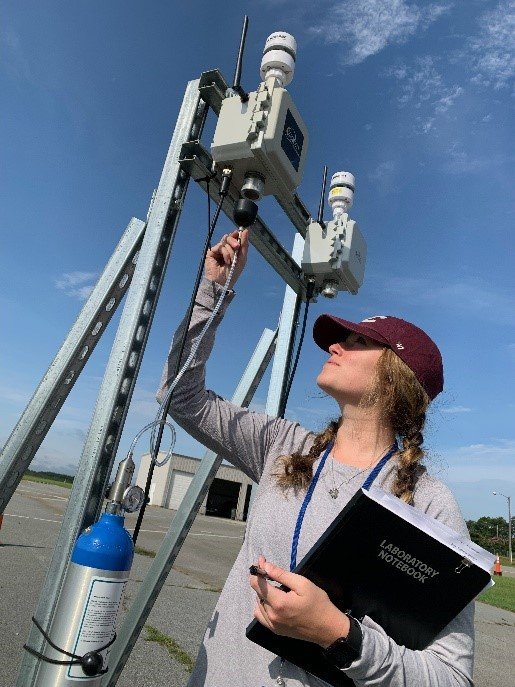EPA Researchers Develop New Air Monitoring Technology to Understand Leaks and Irregular Emissions from Sources

Published October 11, 2022
You can’t see them, and you can’t touch them, but they can escape through industrial processes and impact air pollution. Any guesses? We’ll help you out with the answer: fugitive emissions. Air pollution remains one of the most important environmental issues in the U.S., and EPA is conducting critical research to protect and improve the quality of our air. One research initiative is looking at “fugitive emissions” which are difficult to measure and model.
To help monitor fugitive emissions, EPA’s Next Generation Emission Measurement (NGEM) team developed a prototype fenceline sensor pod (SPod) and demonstrated the technology in an industrial district known as Rubbertown in Louisville, Kentucky. The low-cost, portable sensor system was deployed near chemical facilities to help improve understanding of volatile organic compound (VOC) emissions in the area.
Participating alongside the NGEM team in this research is EPA ORISE Fellow Megan MacDonald. Part of MacDonald’s research focuses on taking large amounts of data from the SPods and transforming it into useful information. “My masters’ degree is in data analytics so I was excited to have a giant data set handed to me,” said MacDonald.
To comb through all the data, MacDonald developed an R Shiny App called EPA SEnsor NeTwork Intelligent Emissions Locator (SENTINEL). This app takes the raw SPod data and cleans and processes it to ultimately gain a better understanding of what large amounts of data look like over a period of months. The goal of this app is to build an understanding of the overall emissions pattern at the current research site and eventually other industrial facilities in the future. The first of its kind, Megan’s app could revolutionize how we look at data from the SPods and similar technologies.
The SPod prototype itself is unique. The EPA custom-built SPods used in Rubbertown were composed of a wind sensor, 10.6 eV photoionization detector (PID), which uses ultraviolet rays to detect VOCs, and a canister system that collects air samples when a pollutant is detected. The SPods were placed in locations near the facilities in pairs. The SPod work is described in a recent publication titled “Demonstration of VOC Fenceline Sensors and Canister Grab Sampling near Chemical Facilities in Louisville, Kentucky.”
Over the course of the 19-month study, an ample amount of SPod data were collected. Eben Thoma, a lead researcher for this study said, “This NGEM demonstration study proved the value of EPA’s open-source SPod fenceline sensor and helped pave the way for improved commercial versions of the technology.”
The SPods collected over 200,000 five-minute average data points for each pair of sensors. In addition, the side-by-side sensors provided similar readings for wind and VOC concentrations, providing more confidence in the data. Some of the most crucial data received from the study demonstrated the SPod and triggered-canister’s ability to detect elevated concentration levels of hazardous air pollutants (HAPs) including 1,3-butadiene and cyclohexane.
One of the main goals of NGEM research is to understand how we can use new NGEM technology to improve air quality monitoring and community well-being. This study is helping advance those goals by demonstrating the use of the SPods to help monitor air pollution in an industrial community
With many new projects on the way, the future of NGEM technology is bright. EPA is conducting research studies not only in Kentucky but other parts of the country as well. In Corpus Christi, Texas, a modified version of the SPod was used for in-plant leak detection analysis. In Greensboro, North Carolina, fenceline SPod’s are being deployed near fuel storage tank sites to help reduce fugitive emissions from leaks and transfer of fuel.
Another project that emerged from the Rubbertown NGEM study is a new participatory science project in which a mobile phone app is being developed called “Odor Explore.” This app will allow communities to report odors they experience and view odor reports on a map that are submitted by other people. The app is being piloted in Rubbertown, coinciding with the NGEM research going on in the area. EPA researchers are hopeful that the data from the Odor Explore app can be combined with new NGEM approaches to understand air emissions that contribute to odor problems.
EPA is collecting a substantial amount of air data from many NGEM projects. By advancing NGEM technology and tools to make large amounts of complex data useful, EPA is providing resources to understand fugitive emissions to ultimately protect the air we breathe. Learn More:
